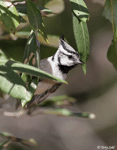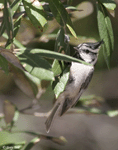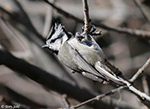| Length: 5.25 inches | Wingspan: 8 inches | Seasonality: Non-resident in South Dakota |
| ID Keys: Obvious crest, black and white facial pattern with black chin and eyestripe, gray above, white below | ||
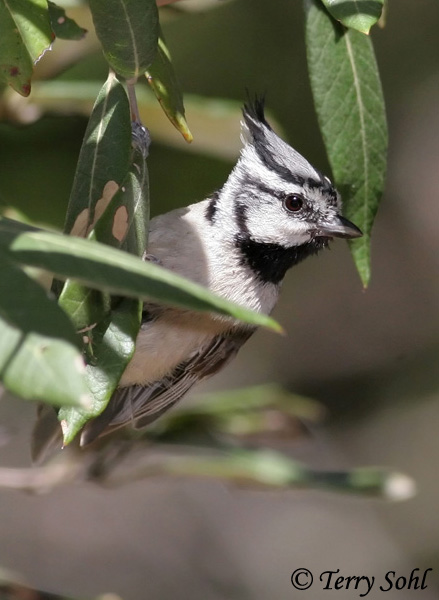 The
Bridled Titmouse has a small range within the southwestern United States,
but within that range it is very common. The majority of the range of
the species is in Mexico. They are the most ornately plumaged of the
titmice, with a beautiful head and chin pattern that makes the species look
more like a chickadee at a distance, than a titmouse.
The
Bridled Titmouse has a small range within the southwestern United States,
but within that range it is very common. The majority of the range of
the species is in Mexico. They are the most ornately plumaged of the
titmice, with a beautiful head and chin pattern that makes the species look
more like a chickadee at a distance, than a titmouse.
Habitat: Found in oak and pine-oak woodlands, typically in areas with live oak species. They can also be found in riparian cottonwoods and willows.
Diet: Feeds on insects, seeds, and acorns.
Behavior: Feeds by gleaning insects from vegetation foliage. They clamber through the vegetation in search of insects, often hanging upside down as they do so. They are very social birds, with small roving flocks typically forming outside of the breeding season.
Nesting: The nest of a Bridled Titmouse is in a cavity in a tree, typically an old woodpecker hole. They have also learned to use artificial nest boxes of appropriate size. It is thought that the female alone incubates the eggs while both parents feed and help tend to the young after they hatch. There is some evidence that Bridled Titmice have complex social and breeding relationships, with birds other than the parents possibly helping to feed and raise young.
Song: Song of a Bridled Titmouse is series of fast whistled phrases.
Migration: Considered a permanent resident throughout its range. However, there is some very short-distance elevational movement to lower elevations in winter in some areas.
Interactive eBird Map: Click to access an interactive eBird map of Bridled Titmouse sightings
Similar Species: Distinctive if seen well. In range, perhaps most likely to be confused with Mountain Chickadee, in terms of plumage, but structural differences (and crest) are obvious with Bridled Titmouse.
Conservation Status: Common even within its small U.S. range, populations appear to be stable. The IUCN lists the Bridled Titmouse as a species of "Least Concern".
Further Information: 1) WhatBird - Bridled Titmouse
2) New Mexico Partners In Flight - Bridled Titmouse
3) Audubon Guide - Bridled Titmouse
Photo Information: Photo taken on May 4th, 2008 - Ramsey Canyon in southern Arizona - Terry Sohl
| Click below for a higher-resolution map |
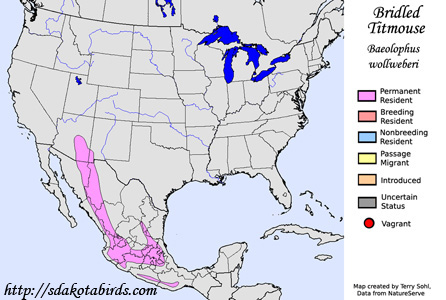 |
| South Dakota Status: Non-resident in South Dakota |
Additional Bridled Titmouse Photos
Click for a higher-resolution version of these photos
